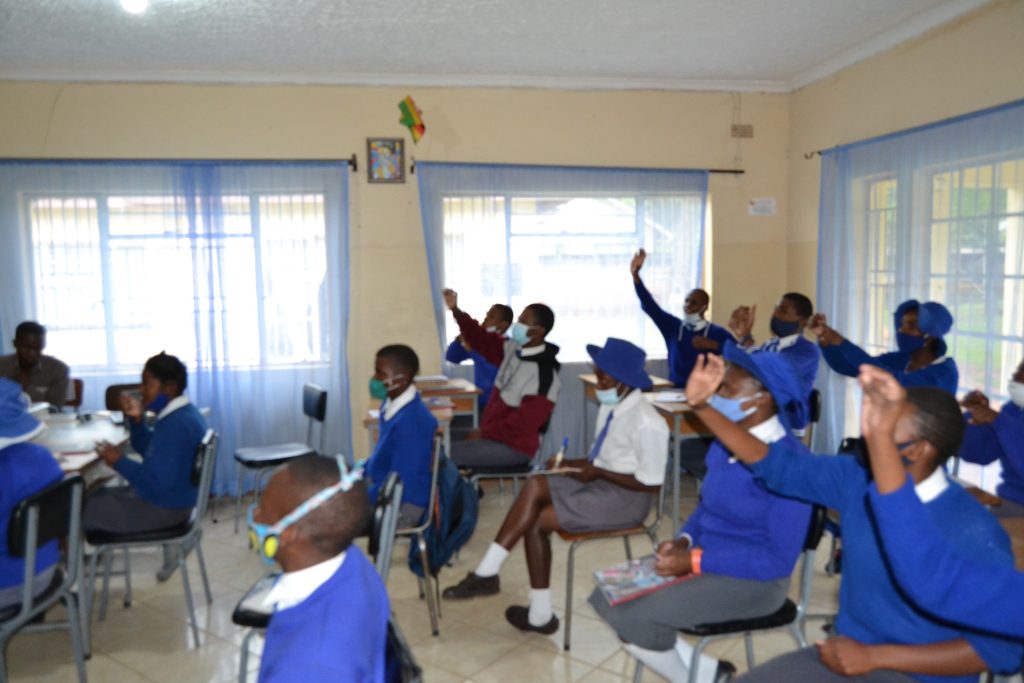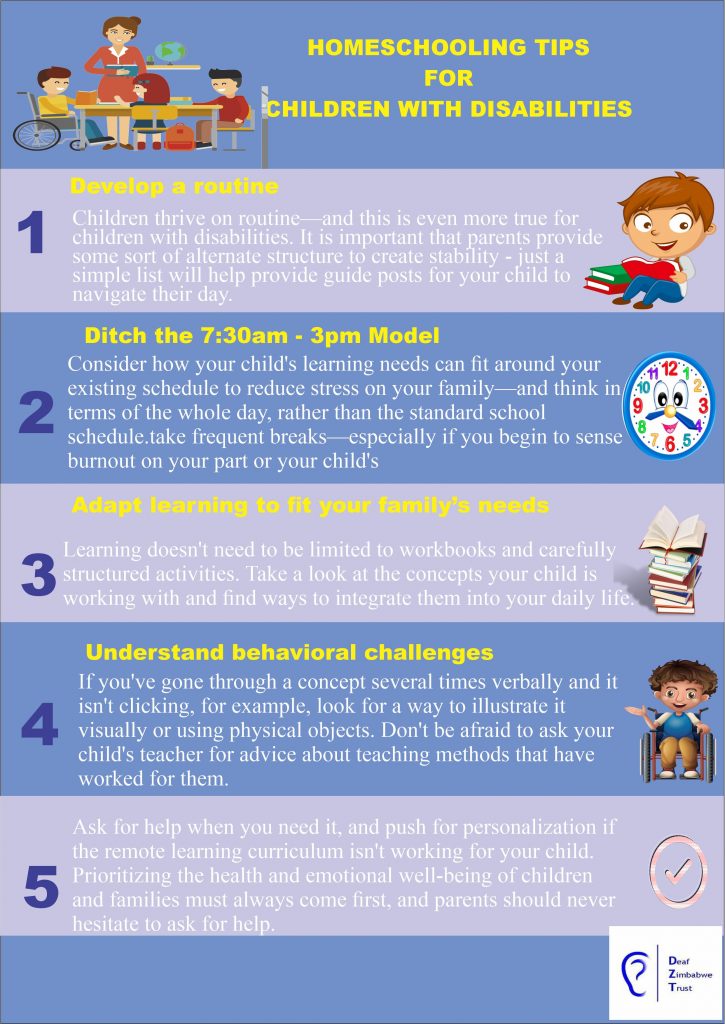PWDs prioritization crucial during vaccination

By Tinotenda Chikunya
Deaf Zimbabwe Trust has called for the prioritisation of persons with disabilities in the vaccination program saying vaccine drives should deliberately target persons with disabilities in order to ensure no one is left behind.
Speaking during a radio interview, DZT Media and Communications Officer Tinotenda Chikunya said there is need for specific considerations to support equitable vaccine access as persons with disabilities face several barriers on access to health.
“It is important to come up with initiatives that target the disability community as currently health centres may be physically inaccessible”.
“Vaccination centres should be universally accessible and must be located closer to the communities of persons with disabilities to ensure that those with mobility challenges manage to reach the centres”
She added that since the advent of COVID-19 Persons with disabilities have struggled to access information in accessible formats which could also be a barrier to vaccination.
“There are many myths surrounding the vaccine and most People with Disabilities have cited that as the reason for vaccine hesitancy , information should be disseminated in accessible formats which include Sign Language , Braille and easy to read text in order to demystify these myths ”.
“The attitude of family members and caregivers and the need for assistance when moving around can be a barrier when persons with disabilities want to get vaccinated, caregivers may refuse to accompany PWDs to vaccination centres”
Chikunya also highlighted that prioritisation of PWDs at health centres will go a long way in encouraging persons with disabilities to get vaccinated.
She called on government to ensure that health service providers are knowledge on how to assist persons with disabilities and to also consider door to door vaccination in communities of persons with disabilities like Caledonia and Riverside in Glen View 1.
COVID-19 and school closures for learners with disabilities

By Mirirai Nyabvure
Around the globe, learners and their families have been significantly affected by the school closures. Nationally, the government has responded by holding classes remotely, largely online to ensure that students continue to study. However, the focus on online learning means that many learners with disabilities are left behind. This measure does not address educational discontinuity and disruption for all students. Online learning platforms and resources need to be available and all students’ needs must be accommodated in order for governments, schools and teachers to ensure that learners are not left behind during school closures.
The challenges faced by learners with disabilities are numerous.
- Children with disabilities are among the most vulnerable – facing multiple forms of exclusion linked to education, health, gender equity, and social inclusion. Those living in poverty are at risk of further marginalization.
- The schooling and learning deficit experienced by learners with disabilities impedes the ability to earn income as adults, which impacts individuals, households, and communities, contributing significantly to a country’s human capital gap.
- The digital divide exacerbates the learning divide among learners related to accessing equipment, electricity, and the internet for learners with disabilities who have an additional barrier of inaccessible learning content. Also, many remote learning options are not accessible to visually impaired and Deaf learners.
But, Covid-19 obliges us to rethink remote learning with an inclusive lens, where every child, whether they have a disability or not, can access and participate in learning that takes place away from the classroom. Ensuring that all learners with disabilities continue to receive quality education requires urgent actions that consider their specific needs for accessible, adapted and individualized learning plans. Blended approaches combining lower tech or no tech solutions, captioning and sign-language options, and including integrating remedial classes can better support those who have been excluded from home-based learning and ensure that social and emotional needs are met.
- Adopt a twin-track approach to disability inclusion in all phases of response: relief (immediate actions needed), recovery (medium-term actions to ensure safe reopening), and resilience (long-term actions).
- Use the principles of Universal Design for Learning (UDL) to ensure multiple means of engagement, representation, and expression are utilized for learners to think, develop skills, and grow while at home.
- Information should be wide-reaching and available in multiple languages and multiple accessible formats to reach learners and families of children who are at risk of being excluded.
- It is crucial to support teachers in three core areas: resilience, instruction, and technology- training must focus on responding to learning loss as well as supporting parents to engage while learners with disabilities are compelled to stay at home.
- Support leaders in different levels of education systems from ministries of education to school leaders to facilitate collaboration with line ministries (such as ministries responsible for finances, social protection, health, data collection, transport, water and sanitation, infrastructure etc.) and a variety of relevant stakeholders in the community and private sector supporting inclusive education and building an inclusive society.
- Support teachers to implement inclusive pedagogy and use a variety of accessible virtual or broadcasted and printed learning materials for distance learning and contact teaching to support all students to learn now and when schools reopen by utilizing various forms of communication to support all learners, inclusive of learners with disabilities for example with the support of captions, larger print, Braille, sign-language, etc.
- Support families and students with diverse learning needs through individual support and check-ins during the distance learning and utilize available resource staff, specialists, volunteers or community members with the skill set to support learners with disabilities with particular sensitivity to trauma and effects of COVID19.
- Governments should help schools urgently reach out to children with disabilities and ensure they can continue their studies and any support services during school closures.
TIPS FOR HOMESCHOOLING LEARNERS WITH DISABILITIES

By Mirirai Nyabvure
- Develop a Routine
Children thrive on routine—and this is even more true for children with intellectual disabilities. The structure that most students had before COVID-19 is all but gone, so it’s especially important that parents provide some sort of alternate structure to create stability. Our experts suggest writing out a routine and talking it through with your child each morning—even if it’s filled with very simple tasks—just a simple list will help provide guideposts for your child to navigate their day.
- Ditch the 7:30am-3pmModel
The school learning environment, with its frequent breaks and interaction with a variety of people, is very different from sustained home learning.
An older child’s attention span maxes out at about 20 minutes, so it’s not realistic to expect any child to sit in front of a computer screen and learn for many consecutive hours of the day, especially if they have attention issues. Quality is more important than quantity.
Consider how your child’s learning needs can fit around your existing schedule to reduce stress on your family—and think in terms of the whole day, rather than the standard school schedule.
While you are in learning mode, take frequent breaks—especially if you begin to sense burnout on your part or your child’s. Quick, physical tasks can be made into games and are a good way to redirect energy and focus.
- Adapt Learning to Fit Your Family’s Needs
Learning doesn’t need to be limited to workbooks and carefully structured activities. Take a look at the concepts your child is working with and find ways to integrate them into your daily life.
Understand Behavioural Challenges
Kids know that their parent is not their teacher. These are different roles in their lives, and children are very literal—these two roles coming together can cause resistance and conflict, especially since students are more likely to be vocal and talk back to their parents than to their teachers. The integration of learning into daily life can be helpful here, as well—as can taking frequent breaks and taking time to cool down when either party becomes frustrated.
If you’ve gone through a concept several times verbally and it isn’t clicking, for example, look for a way to illustrate it visually or using physical objects.
Don’t be afraid to ask your child’s teacher for advice about teaching methods that have worked for them.
Ask for help when you need it, and push for personalization if the remote learning curriculum isn’t working for your child.
At the end of the day, it’s important to recognize that every family—like every school and district—is facing unique challenges and traumas during the pandemic. Caregivers are being asked to do a lot, and for many, assisting students with remote education has presented a series of impossible trade-offs. Prioritizing the health and emotional well-being of children and families must always come first, and parents should never hesitate to ask for help.
